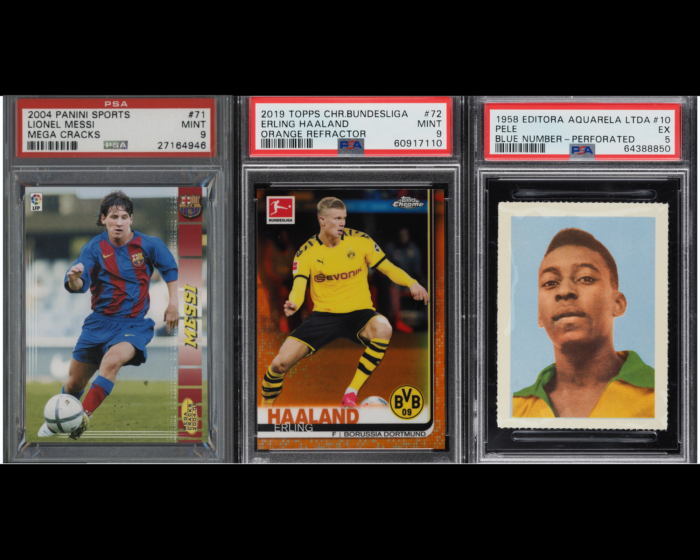
This Week in Soccer Cards – 03/24/2023
I. Major Recent Sales Messi is on top of our list with the highest winning
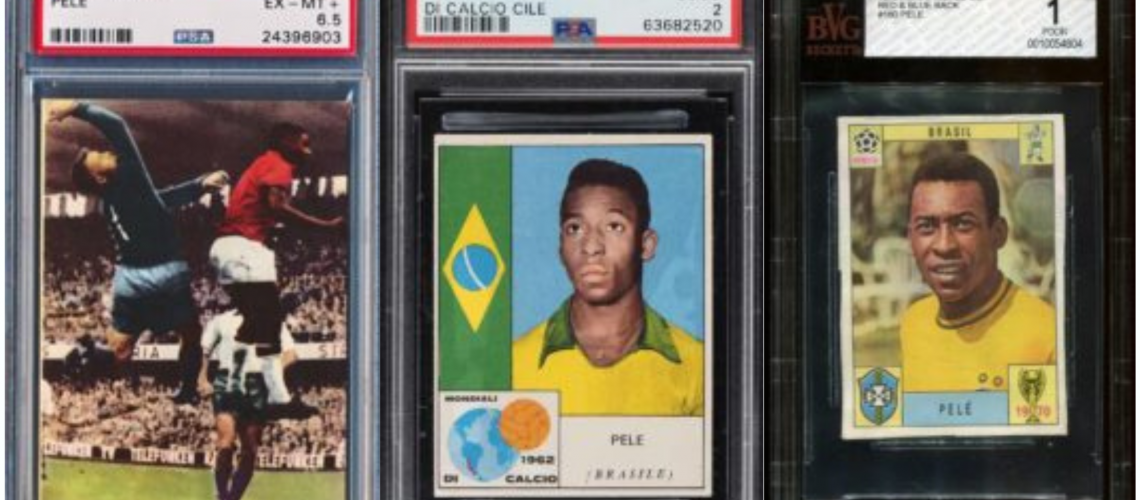

Click edit button to change this text. Lorem ipsum dolor sit amet consectetur adipiscing elit dolor
Pele is a name that won’t be forgotten. It’s a name that every soccer fan knows about and will be forever recognized as the greatest player in the history of soccer.
Born as Edson Arantes do Nascimento on October 23, 1940 in Minas Gerais, Brazil. Pele did not have the world handed over to him on a silver and gold platter. He worked his way with sweat and blood to the success he attained.
To commemorate his life, we give you these card entries highlighting Pele’s career.
In 1956, Waldemar de Brito, a former national team player who recognized Pele’s ability, took Pelé to Santos, an industrial and port city located near São Paulo, to try out for the professional club Santos FC, telling the directors at Santos that the 15-year-old would be “the greatest football player in the world”. Pelé impressed Santos coach Lula during his trial at the Estádio Vila Belmiro, and he signed a professional contract with the club in June 1956. When the 1957 season started, Pelé was given a starting place in the first team and, at the age of 16, became the top scorer in the league.
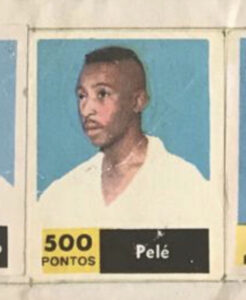
A Americana Ltda released this card in 1957 in Brazil. This card is another variant of the A Americana Ltda cards released in the same year. This variant shows Pele on a blue background and the text 500 Puntos is written beside Pele’s name.
His first match was against the USSR in the third match of the first round of the 1958 FIFA World Cup, where he gave the assist to Vavá’s second goal. He was at the time the youngest player ever to participate in the World Cup. Against France in the semi-final, Brazil was leading 2–1 at halftime, and then Pelé scored a hat-trick, becoming the youngest player in World Cup history to do so. On 29 June 1958, Pelé became the youngest player to play in a World Cup final match at 17 years and 249 days.
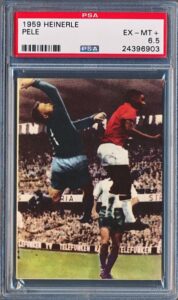
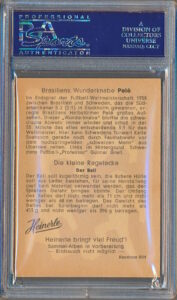
Heinerle issued this card from around 1958 to 1959. The front of the card features an action shot of Pele in the soccer game. On the back of the card is a long paragraph that is written in German.
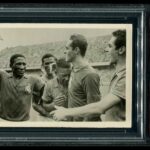
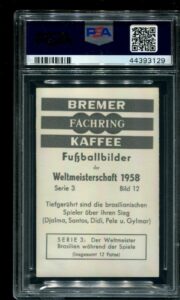
The German coffee company Bremer Fachring Kaffee issued this card in 1958 in Germany. The card features an iconic photo of Pele crying with other Brazillian team members after winning the 1958 World Cup.
In the 1958 World Cup Pele finished the tournament with six goals in four matches played and was named the best young player of the tournament. The press proclaimed Pelé the greatest revelation of the 1958 World Cup, and he was also retroactively given the Silver Ball as the second-best player of the tournament, behind Didi. Pelé continued to impress after heading back to Brazil where he won his first major title with Santos in 1958 when the team won the Campeonato Paulista; He finished the tournament as the top scorer, with 58 goals, a record that still stands today.
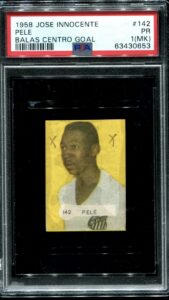
This Pele card was released by Jose Innocente in 1958. The card features Pele in a white shirt on a yellow background.
Pelé also played in the South American Championship. In the 1959 competition, he was named best player of the tournament and was the top scorer with eight goals, as Brazil came in second despite being unbeaten in the tournament. He scored in five of Brazil’s six games, including two goals against Chile and a hat-trick against Paraguay.
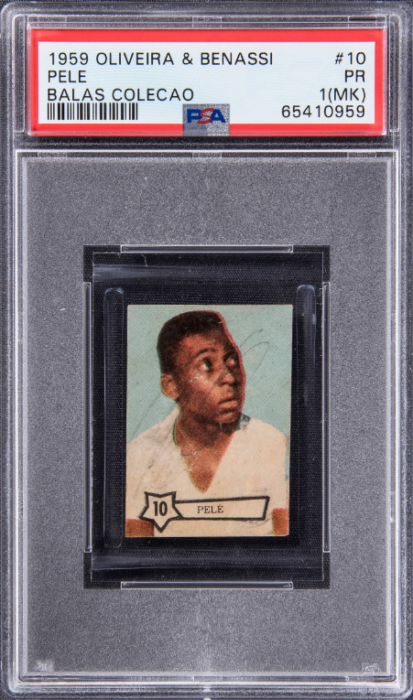

Oliveira & Benassi issued this card in 1959 that features a photo of young Pele wearing a white shirt. On the back of the card text is written in Portuguese.
When the 1962 World Cup started, Pelé was the best-rated player in the world In the first match of the 1962 World Cup in Chile, against Mexico, Pelé assisted the first goal and then scored the second one, after a run past four defenders, to go up 2–0. He got injured in the next game while attempting a long-range shot against Czechoslovakia. This would keep him out of the rest of the tournament. It was Garrincha who would take the leading role and carry Brazil to their second World Cup title, after beating Czechoslovakia in the final in Santiago.
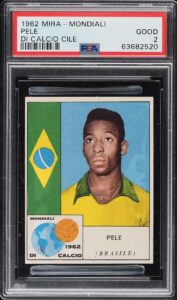
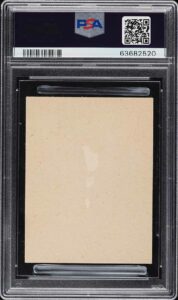
In 1962 Mira Mondiali issued this card in Italy. This card features Pele on a pale blue background with the Brazillian flag printed to his left.
The balé branco (white ballet), the nickname given to Santos at the time, managed to retain the title after victories over Botafogo and Boca Juniors. Pelé helped Santos overcome a Botafogo team that featured Brazilian greats such as Garrincha and Jairzinho with a last-minute goal in the first leg of the semi-finals. In the second leg, Pelé scored a hat-trick in the Estádio do Maracanã as Santos won, 4-0, in the second leg. Santos started the final series by winning, 3–2, in the first leg and defeating Boca Juniors 1–2, in La Bombonera. It was a rare feat in official competitions, with another goal from Pelé. Santos became the first Brazilian team to lift the Copa Libertadores on Argentine soil. Pelé finished the tournament with five goals.
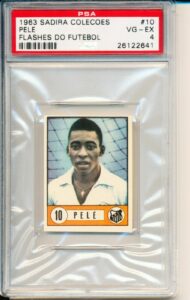

In 1963 Sadira issued this card that features Pele’s portrait in a white shirt, an orange tab is found below Pele’s portrait with his name on it.
Pelé was the most famous footballer in the world during the 1966 World Cup in England. Brazil was eliminated in the first round, playing only three matches. The World Cup was marked, among other things, by brutal fouls on Pelé that left him injured by the Bulgarian and Portuguese defenders.
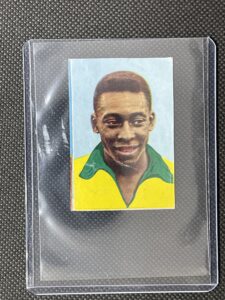
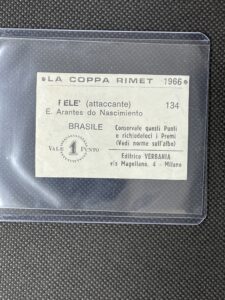
The 1966 Editrice Verbania Pele was released in honor of the World Cup. The card features a portrait of Pele on the front of the card. This is the more rare variation with the text “Vale 1 Punto” can be found. This translates to English as “Worth 1 Point” and was a short print because kids would collect the cards worth points and turn them in for prizes.
In 1969, the two factions involved in the Nigerian Civil War agreed to a 48-hour ceasefire so they could watch Pelé play an exhibition game in Lagos. Santos ended up playing to a 2–2 draw with Lagos side stationery Stores FC and Pelé scored his team’s goals. The civil war went on for one more year after this game.
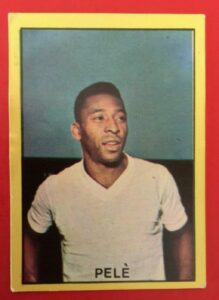
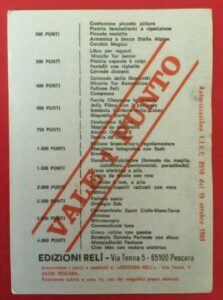
This variation of the 1969 Reli Pele card boasts a bright yellow border, and features a photo of Pele wearing a white shirt. On the back of the card, the text ” Vale 1 Punto” can be found which translates to “Worth 1 point”. This is another card that was collected and turned in for prizes by children.
Pelé was called to the national team in early 1969, he refused at first, but then accepted and played in six World Cup qualifying matches, scoring six goals. Brazil played Italy in the final at the Azteca Stadium in Mexico City. Pelé scored the opening goal with a header after outjumping Italian defender Tarcisio Burgnich. Brazil’s 100th World Cup goal, Pelé’s leap of joy into the arms of teammate Jairzinho in celebrating the goal is regarded as one of the most iconic moments in World Cup history. The play culminated after Pelé made a blind pass that went into Carlos Alberto’s running trajectory. Brazil won the match 4–1, keeping the Jules Rimet Trophy indefinitely, and Pelé received the Golden Ball as the player of the tournament.
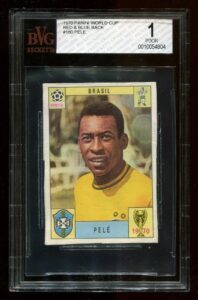

The Red / Blue back is the rarest of all backs for the 1970 Panini set. This was only released as an insert intended to be hand cut out of the Italian album (as opposed to other variations that were released in packets (i.e., packs).
Pele came out of semi-retirement to sign with the New York Cosmos of the North American Soccer League (NASL) for the 1975 season. Pelé made his debut for the Cosmos on 15 June 1975 against the Dallas Tornado at Downing Stadium, scoring one goal in a 2–2 draw. Pelé opened the door for many other stars to play in North America.
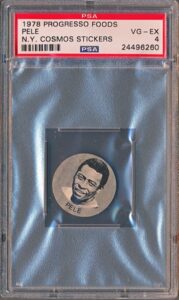
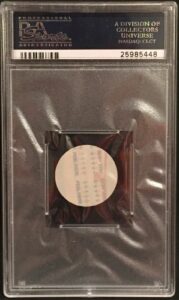
This disc-like sticker was issued by Progresso Foods in celebration of the New York Cosmos in 1975. It is one of very few issues printed in the US during Pele’s career in America.
After retiring in 1977, Pelé was a worldwide ambassador for football and made many acting and commercial ventures. In 2010, he was named the honorary president of the New York Cosmos.
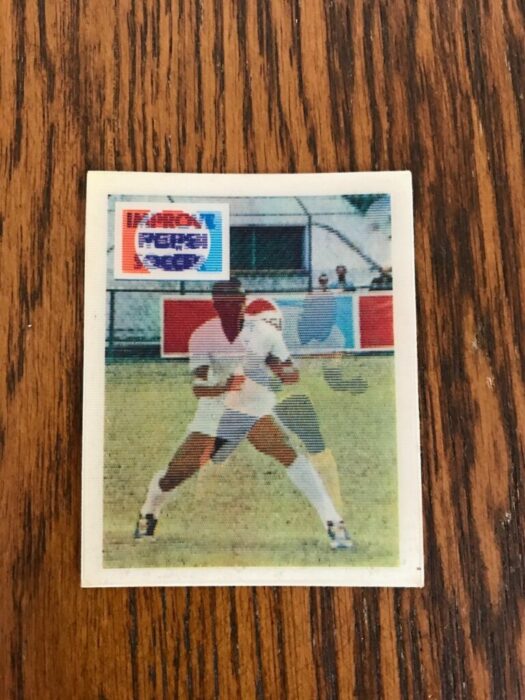

Pepsi issued this set in 1978 that features Pele showing different actions to play the soccer sport. There are 4 cards in this set. This is another of the few cards printed in the US during Pele’s career in America.
In his career, Pele made himself the top scorer in Brazilian national team history and FIFA history. He also set a record for the most FIFA World Cup wins for an individual, with three medals to his name. The young Pele burned bright, becoming the youngest player to score a hat-trick and the youngest player to score in a World Cup final match.
However, Pele did not only contribute to soccer. In his retirement, Pele went on to campaign for a variety of causes, including poverty reduction, anti-corruption movements, and environmental protection. The biographical details and trivia of Pele’s life won’t be enough to describe and explain the greatness of Pele, but the legacy that he left on the field will.
As Pele said, “Success is no accident. It is hard work, perseverance, learning, studying, sacrifice, and most of all, love of what you are doing or learning to do.” It is not luck that Pele was the greatest, but instead his sacrifice, sweat, and blood are evidence of how he worked hard for the success he had.

I. Major Recent Sales Messi is on top of our list with the highest winning
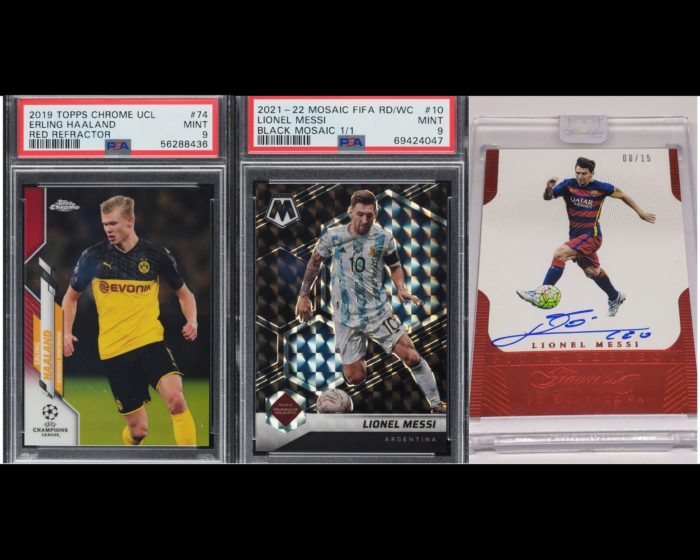
I. Major Recent Sales For this week’s sale, Haaland garnered the highest bid of $16,200, with 2 entries for this week. This was followed
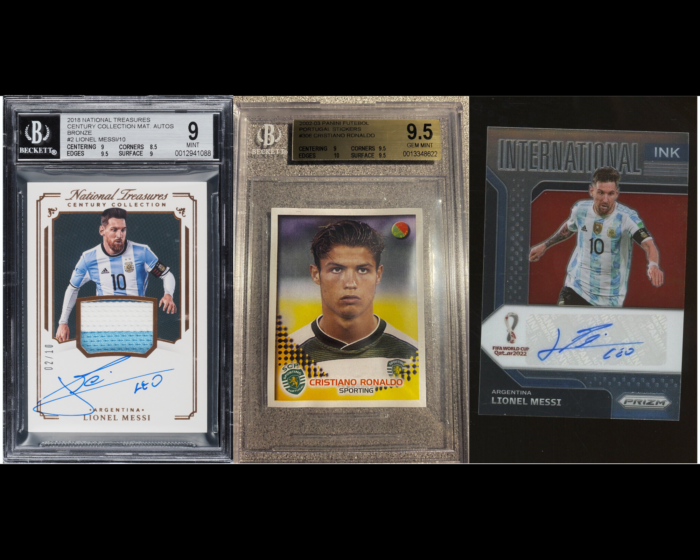
I. Major Recent Sales Messi is on top of our list for this week’s sale with 9 entries, this includes a dual booklet from Topps
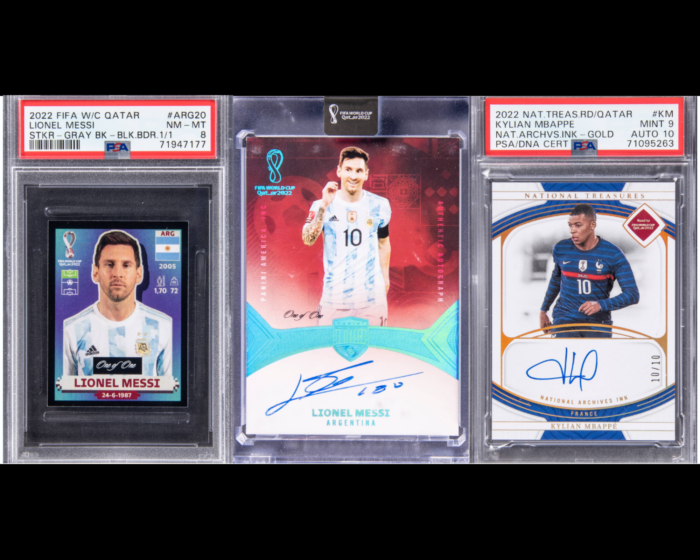
I. Major Recent Sales Like last week’s sale, Messi is on top of our list with 10 entries for this week’s sale and the highest
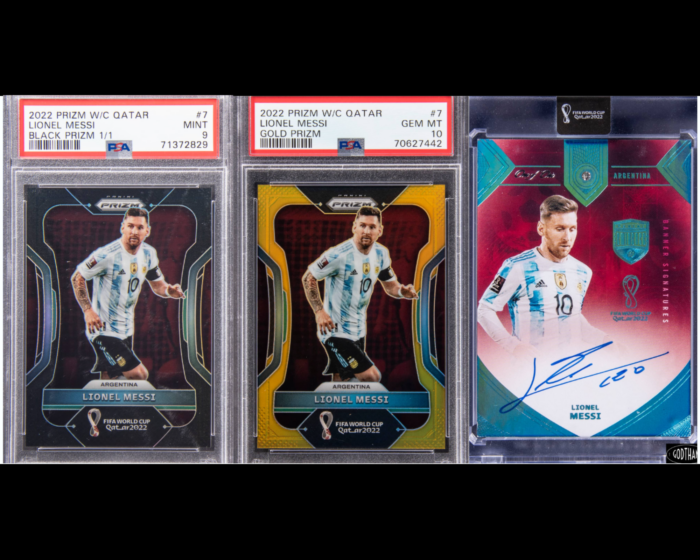
I. Major Recent Sales This is our list of the most 25 most significant soccer card sales from the last week, from the major auction

I. Major Recent Sales Topping out our list for this week’s sale is Haaland with the highest winning bid of $9000. Ronaldo and Mbappe round
© Copyright PeleCards 2022